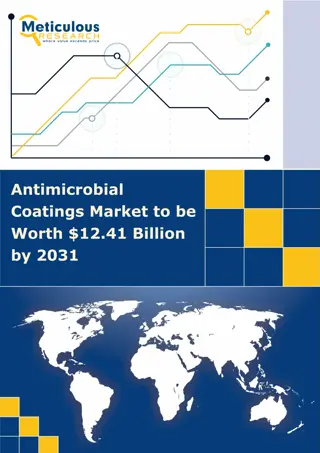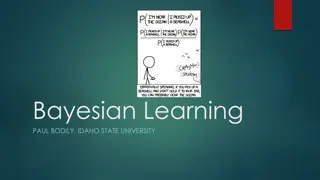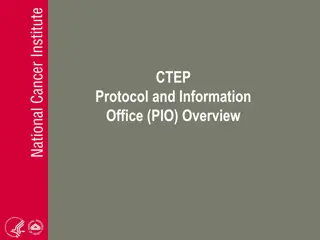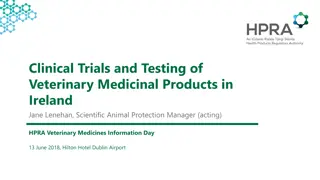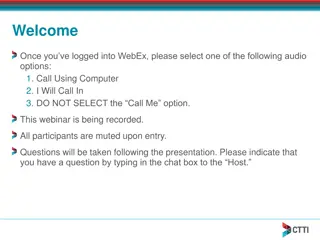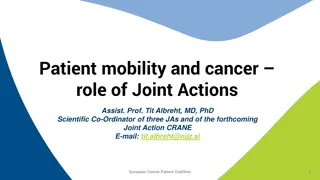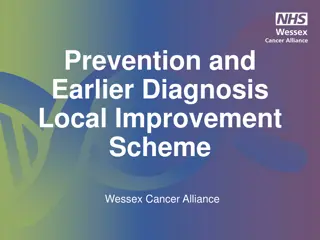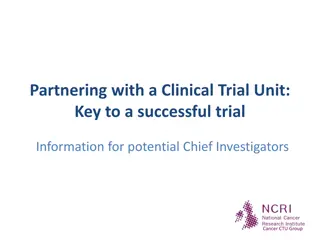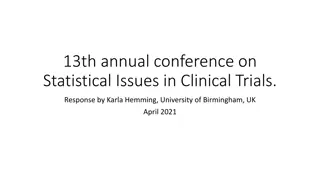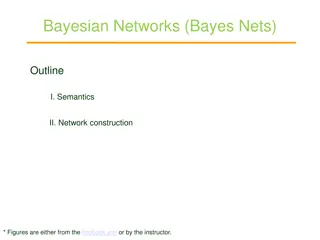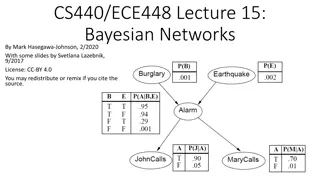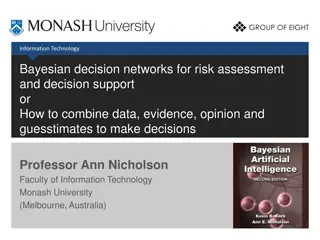Bayesian Approach in Pediatric Cancer Clinical Trials
Pediatric cancer clinical trials benefit from Bayesian analysis, allowing for the incorporation of uncertainty in prior knowledge and ensuring more informed decision-making. The use of Bayesian methods in the development of cancer drugs for children and adolescents, as emphasized by initiatives like the RACE for Children Act, offers a promising pathway to accelerate cures and ensure equity in treatment. Through case studies such as NDA22068 Nilotinib, Bayesian analysis proves invaluable in assessing efficacy and guiding drug development in pediatric oncology.
Download Presentation

Please find below an Image/Link to download the presentation.
The content on the website is provided AS IS for your information and personal use only. It may not be sold, licensed, or shared on other websites without obtaining consent from the author. Download presentation by click this link. If you encounter any issues during the download, it is possible that the publisher has removed the file from their server.
E N D
Presentation Transcript
A Bayesian Approach in Design and A Bayesian Approach in Design and Analysis of Pediatric Cancer Clinical Trials Analysis of Pediatric Cancer Clinical Trials Jingjing Ye, PhD BeiGene PSI Journal Club: Bayesian Methods Nov. 17, 2020
Outline Background Using a case study to illustrate potential useful Bayesian analysis Analysis and monitoring Design study Conclusions
Cancer Drug Development for Children and Adolescents Well recognized, long-standing challenges-biologic, societal, economic Widely leverages adult drug discovery and development Many targeted agents likely applicable to cancers in children
RACE for Children Act: Incorporated as Title V of the FDA Reauthorization Act (FDARA), enacted Aug. 18, 2017 Requires evaluation of new molecularly targeted drugs and biologics intended for adult cancers at a molecular target substantially relevant to the growth or progression of a pediatric cancer Molecularly targeted pediatric cancer investigation: clinically meaningful study data Elimination of orphan exemption for pediatric studies for cancer drugs directed at relevant molecular targets RACE for Children Act: Research to Accelerate Cures and Equity Act; come into force, 8/18/2020
Bayesian Analysis Bayesian Analysis Account uncertainty in prior knowledge Decision making and interpretation with probability thinking Use relevant prior information If not sure of relevance, incorporate P(relevance) If very sure of relevance, be skeptical about potential efficacy unless you trust experts
Bayesian on Pediatric Cancers Pediatric Specific Indication Bayesian analysis Older age group Control Partial Extrapolation Bayesian analysis Adult Older age group Discount priors Sensitivity on the priors Interpretation on efficacy in posterior probability
Case Study: NDA22068 Nilotinib Case Study: NDA22068 Nilotinib Adult Newly diagnosed Ph+ CML in chronic phase MMR at 12 month Randomized Pediatric Newly diagnosed Ph+ CML in chronic phase MMR at 12 month Single-arm N=25 Indication Endpoint Design Sample Size Nilotinib N=282 versus imatinib N=283 Age 18+ Results* 44% (38.4, 50.3) Philadelphia chromosome positive chronic myeloid leukemia (Ph+CML) MMR: major molecular response (MMR; BCRABL/ABL 0.1% IS); * Results are for MMR, for other information refer to USPI https://www.accessdata.fda.gov/drugsatfda_docs/label/2018/022068s027lbl.pdf 2-18 60% (38.7, 78.9)
Pediatric Cancer Case Study Bayesian analysis and sequential monitoring Bayesian study design with sequential monitoring
Bayesian Analysis and Sequential monitoring Bayesian Analysis and Sequential monitoring
Prior Distributions Prior Distributions Probability of applicability: Prior=(1-a)*f(D) + a*g(D) f(D): skeptical prior, g(D): adult study a=P(applicability of adult results) Adult N=282 44% (38.4, 50.3)
Prior Distribution Prior Distribution
Prior + Likelihood Prior + Likelihood
Posterior Distribution Posterior Distribution
Posterior Probability of Efficacy Posterior Probability of Efficacy Posterior Prob. of Efficacy Pr(Response>30%) Bayesian Estimate (95% Cred. Int.) Prior 42.3 Skeptical 94.5% (27.4, 58.2) 50 (35.8, 64.2) 50 (35.6, 64.2) 59.5 (40.6, 76.6) 100% adult 99.8% 50% mixture 99.7% Non-informative 100% Even given skeptical prior, the posterior probability is 94%+
Sequential Monitoring Sequential Monitoring First evaluation when N=5 patients results available Evaluate as data accumulate
Sequential Monitoring Sequential Monitoring Posterior prob > 97.5% when 10 responders observed out of 19 enrolled
Bayesian Characteristics Bayesian Characteristics Skeptical prior: centered at no clinically-meaningful response and low probability of observing higher response Adult/Enthusiastic prior: centered at adult efficacy and low probability of observing low response
Sequential Design Property Sequential Design Property Accrual up to 50 patients Stop for efficacy if Posterior Pr(R>0.3|Data, Skeptical) >= 0.975 Stop for futility if Posterior Pr(R<0.35|Data, Enthusiastic)>=0.85
Sequential Design Property Sequential Design Property - - Non Enthusiastic priors Enthusiastic priors Accrual up to 50 patients Stop for efficacy if Posterior Pr(R>0.3|Data, NI) >= 0.975 Stop for futility if Posterior Pr(R<0.35|Data, Enthusiastic)>=0.85 Non- -informative + informative +
Approaches on Addressing Challenges International collaboration in pediatric cancer trials when possible, avoid duplication and competition Bayesian designs and analysis formally incorporate prior knowledge into the trials quantify uncertainty intuitive interpretation based on probability thinking
Addressing Challenges (Contd) Bayesian sequential monitoring offers flexible monitoring of pediatric trial results as data accumulates Combined with Skeptical and enthusiastic priors, the plan offers good trial design properties, including frequentist- equivalent controlled false-positive rate and sufficient power Offers options to stop for trial early for both efficacy and futility, advantage of requiring fewer patients
A Bayesian is one who asks you what you think before a clinical trial in order to tell you what you think afterwards. - Senn, 1997b
References https://www.fda.gov/AboutFDA/CentersOffices/OfficeofMedicalProductsandTobacc o/OCE/ucm544641.htm https://www.fda.gov/AdvisoryCommittees/CommitteesMeetingMaterials/Drugs/On cologicDrugsAdvisoryCommittee/ucm612242.htm https://www.fda.gov/downloads/drugs/guidances/ucm425885.pdf https://www.fda.gov/downloads/Drugs/GuidanceComplianceRegulatoryInformation /Guidances/UCM609513.pdf https://www.fdanews.com/ext/resources/files/2019/03-14-19- Trials.pdf?1552594371 https://www.fda.gov/downloads/Drugs/GuidanceComplianceRegulatoryInformation /Guidances/UCM633138.pdf
References https://www.fda.gov/downloads/AdvisoryCommittees/CommitteesMeetingMaterial s/Drugs/OncologicDrugsAdvisoryCommittee/UCM612244.pdf https://www.fda.gov/downloads/drugs/guidances/ucm201790.pdf Woodcock, J., LaVange, L.M., 2017, Master Protocols to Study Multiple Therapies, Multiple Diseases, or Both., NEJM, 2017; 377:62-70 https://www.ncbi.nlm.nih.gov/pubmed/28679092 Harrell, F., 2017, Why is Bayes relevant to CDER? FDA seminar Fayers at al. Tutorial in Biostatistics: Bayesian Data Monitoring in Clinical Trials, Stat in Medicine, 1997 Psioda, 2018, An Introduction to Bayesian Sequential Monitoring of Clinical Trials, FDA Seminar




